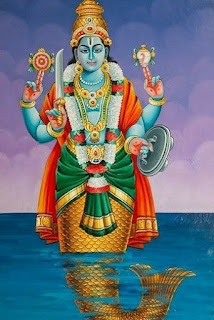In Hinduism Lord Vishnu, One of the principal deities of the religion, is known for his avatars or incarnations. These avatars are believed to descend to earth to restore cosmic order ie Dharma and protect it from evil forces.
The most famous and significant of these avatars are collectively known as the Dashavatara, which means "ten avatars." Each avatar has a unique form and purpose. Here is an overview of these ten avatars:
Matsya (The Fish): Matsya is the first avatar of Vishnuji. In this form, Vishnuji appeared as a giant fish to save the holy scriptures Vedas and seven wise men called sages from a great flood. Matsya guided a boat carrying the sages and various forms of life to safety, ensuring the survival of knowledge and life on earth.
Kurma (The Tortoise): Kurma is the second avatar, where Vishnuji took the form of a giant tortoise. During the churning of the ocean Samudra Manthan by gods and demons to obtain the nectar of immortality, the mountain used for churning began to sink. Kurma supported the mountain on his back, allowing the churning to continue and the nectar to be retrieved.
Varaha (The Boar): In his third avatar, Varaha, Vishnuji became a boar. A demon named Hiranyaksha had hidden the Earth in the cosmic ocean. Varaha dived into the ocean, fought the demon, and lifted the Earth out of the water with his tusks, restoring it to its rightful place.
Narasimha(TheMan-Lion): Narasimha is the fourth avatar, a being who is half-man and half-lion. Vishnu took this form to protect his devotee Prahlada from his demon father,Hiranyakashipu. Hiranyakashipu had a boon that made him almost invincible. Narasimha appeared from a pillar, caught Hiranyakashipu at twilight (neither day nor night), on the threshold (neither indoors nor outdoors), and killed him, thus bypassing the boon.
Vamana (The Dwarf): In his fifth avatar, Vamana, Vishnuji appeared as a dwarf Brahmin. The powerful demon king Bali had gained control over the heavens and the earth. Vamana approached Bali and asked for as much land as he could cover in three steps. When Bali agreed, Vamana grew to a gigantic size, covering the entire universe in three steps, thereby restoring the gods' control over the heavens.
Parashurama (The Warrior with an Axe): Parashurama, the sixth avatar, is depicted as a warrior sage with an axe. He appeared to restore balance when the warrior class (Kshatriyas) became corrupt and oppressive. Parashurama, who was both a Brahmin and a warrior, carried out a campaign to eliminate the corrupt warriors and protect the Brahmins.
Rama (The Prince of Ayodhya): Rama is the seventh avatar and the hero of the epic Ramayana. He is known for his virtuous and just nature. Rama's main task was to defeat the demon king Ravana, who had kidnapped his wife Sita. With the help of his loyal brother Lakshmana and the monkey god Hanuman, Rama defeated Ravana and established a kingdom of peace and prosperity.
Krishna (The Divine Statesman): Krishna, the eighth avatar, is a central figure in the Mahabharata. He played a crucial role in the Kurukshetra War, offering guidance to the Pandava prince Arjuna in the Bhagavad Gita. Krishna is known for his playful childhood, wise counsel, and divine exploits. His teachings emphasize duty, devotion, and the nature of the soul.
Buddha (The Enlightened One): Buddha, the ninth avatar, is considered by some traditions to be an incarnation of Vishnuji. Siddhartha Gautama, who became Buddha, taught compassion, non-violence, and the path to enlightenment. He rejected ritualistic practices and emphasized meditation and ethical living.
Kalki (The Future Warrior): Kalki is the prophesied tenth avatar of Vishnuji, who is yet to appear. It is believed that Kalki will come at the end of the current age, known as Kal Yuga, to eradicate evil and restore righteousness. Kalki is depicted as a warrior riding a white horse and wielding a sword, symbolizing the destruction of evil and the establishment of a new era of truth and virtue.
These avatars illustrate Vishnuji's role as the preserver and protector of the universe, taking different forms to address various cosmic crises and uphold the principles of righteousness.
************
.jpeg)

.jpeg)
.jpeg)
.jpeg)
.jpeg)
.jpeg)
.jpeg)
.jpeg)
.jpeg)
.jpeg)
🙏🙏
ReplyDelete🙏🙏
Delete